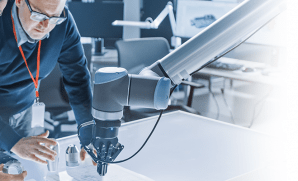This article discusses the common challenges faced during CRM legacy modernization and provides practical solutions.
With Customer relationship management (CRM), the focus has shifted from establishment to crafting a hyper-personalized experience, transcending time and space. Today’s CRM is about delivering tailored interactions that add value, making every engagement effortless and meaningful. However, a lot goes on behind the scenes.
Large and rigid CRM systems bring financial and maintenance burdens and challenges related to user acceptance and data organization. When the implementation of such a CRM system goes awry, the sheer magnitude and intricacy of the project can leave a business severely incapacitated.
At YASH Technologies, we’ve witnessed numerous instances where introducing a new CRM system disrupts operations, leading to significant resource investment in problem resolution. Often, it becomes apparent that external assistance may be necessary. Hence, we caution our readers about potential pitfalls to ensure a seamless CRM implementation. This article discusses significant issues associated with legacy CRMs and offers insights on overcoming them effectively.
Challenges with Legacy Systems:
Most businesses stick to using legacy CRM systems rather than replacing them. In the long run, this means poor user experience, building technical debt, and other disadvantages. To better align with evolving organizational requirements, it is imperative to modernize legacy CRM systems. For instance, businesses have achieved astounding business growth through legacy system modernization like 2x scalability, 15% to 35% reduced infrastructure costs year-over-year, and a minimum 14% increase in annual revenue. This, when juxtaposed with the remaining legacy, produces several problems.
One common sign that a legacy system needs modernization is slow and unresponsive performance. As a business grows, the CRM may struggle to keep up with the increased workload. This can result in slower processing times, longer user wait times, and frustrated employees.
Legacy systems can have many disadvantages, including:
Costly maintenance
Legacy systems require regular maintenance, which can become expensive. Eventually, legacy systems may become too outdated to maintain.
Functionality issues
Your existing CRM may have limited functionality and may not be supported. They may fail at any time.
Compatibility
These systems may require a lot of custom code to work with new technologies. They may not have any straightforward compatibility options.
Unsupported software
Support for underlying technologies may not be available, and the legacy software may not be updated. Without updates, the systems may be vulnerable to breaches.
Data inconsistencies
Data inconsistencies occur when information is transferred from legacy systems to modern software. This can result in data that are duplicated, mismatched, or misplaced.
Integration challenges
Legacy systems can be challenging to integrate with new software. This can create problems for business continuity and business processes.
Compliance
Legacy systems can be expensive for compliance. This is especially true for heavily regulated sectors like healthcare, finance, or law.
Increased security risk – Since legacy systems are outdated, there will be a very high risk of security attacks.
High maintenance and skilled resources– The legacy system requires regular maintenance to function correctly and requires specialist skills to maintain them.
Need for System Modernization and Challenges in its Transition:
Legacy system modernization upgrades outdated software to include current features, infrastructure, and architecture.
Furthermore, system modernization can help businesses keep up with changing technologies and environments. However, several challenges can arise during modernization, ranging from user acceptance and security risks to stakeholder resistance to change. Here are a few common challenges businesses experience.
Legacy System Modernization Challenges:
Data Loss- Legacy systems often contain a vast amount of vital data that must be converted to the new system. Significant data loss is possible during this process, as converting all the old data to new data is difficult.
User acceptance– Changing such a legacy application requires re-training users and needs time to adjust. Transition into the new system will have resistance from the users. Change is hard for regular users, who have been used to working in specific systems in a particular fashion for a long time.
Redesigning and Re-engineering the system – Legacy code was written for a specific platform and functionalities. Refactoring existing codes needs people with highly relevant experience to proceed with care.
Expensive investment-
Technological investments are costly as they involve multiple systems associated with one system.
Overcoming Legacy Systems Challenges Toward Modernization:
Evaluate your legacy system- The first step is evaluating or reviewing the current legacy system. Determine if modernizing the legacy achieves your company’s business objectives and needs.
Select the Right Approach – Modernization efforts should focus on migrating and re-engineering critical components, step by step, to keep disruptions to a minimum.
Starting with a clean slate may also help you clarify your business goals and identify objectives that have been difficult to achieve due to existing IT limitations.
Strategize- Create a strategy regarding impact on technology, architecture, functionality, cost, and risk to determine which modernization method will value the company’s objectives.
Enable your employees– Regarding legacy system modernization, your users may not be enthusiastic about the changes. Still, training can change their perspective and help them become familiar with the new infrastructure faster.
Plan for future upgrades
CRM modernization could disrupt the organization’s everyday processes despite the best efforts. Therefore, it is essential to plan ahead of time. This will help make the process as seamless as much as possible.
Modernizing your CRM system is strategic, demanding the right service provider equipped with best practices and accelerators. Transforming challenges into gains, especially when migrating from legacy CRM to a modern CRM like Salesforce, requires careful consideration and expertise.
A meticulous and collaborative approach is vital; rushing the modernization process may incur costs in terms of price, timeline, and schedule. To navigate this journey successfully, align with a reliable and trusted transformation partner who understands your goals and can guide you toward a seamless transformation. To learn more about our services, contact us at info@yash.com.





